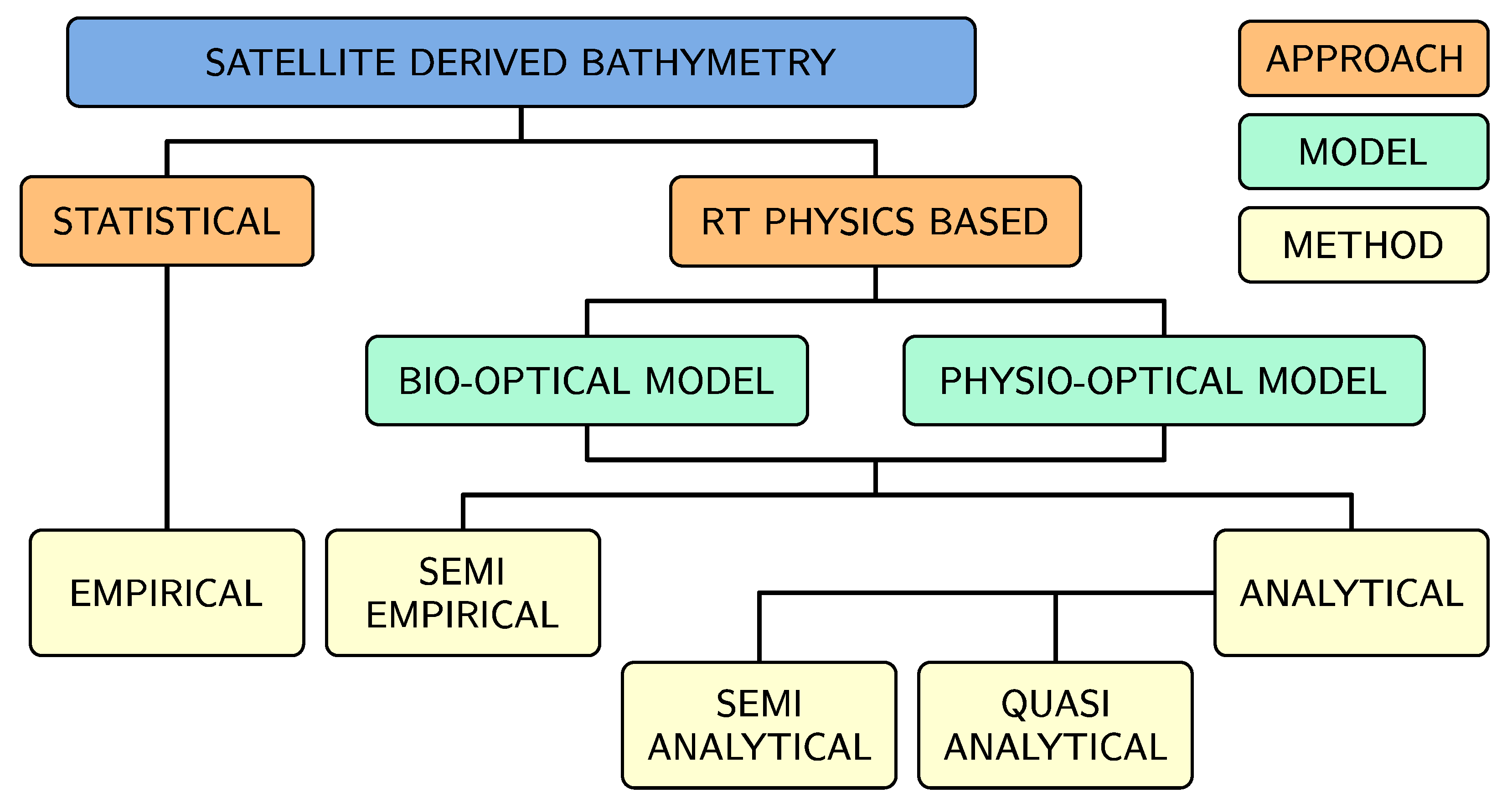Optical Satellite-Derived Bathymetry: An Overview and WoS and Scopus Bibliometric Analysis
Abstract
1. Introduction
2. Materials and Methods
2.1. SDB Methods
| Method | System | Depth Range (m) | Accuracy | Affecting Factors | Advantages | Limitations | Applications |
|---|---|---|---|---|---|---|---|
| Non-imaging Active RS | Light Detection and Ranging (LiDAR) | Up to 70 | Very high ≈ 15 cm | Water clarity or turbidity, bottom material; surface state; background light | Wide depth range; concurrent measurement not essential | High cost; limited swath width | Varied aquatic environments of narrow range |
| Radar altimetry | >1000 | Very Low ± 60 m | The elastic thickness of the lithosphere and/or crustal thickness, sediments | Global coverage, needs only simple altimetry with no iono/troposphere measurement | Possible over a limited wavelength band | Coarse bathymetry derivation in open ocean deep seas | |
| Imaging Active RS | Microwave/SAR Spaceborne | 10–100 | Low 7 m | Image resolution slicks, fronts, weather conditions (e.g., waves) | Applicable over large areas; unaffected by cloud cover | Complex and not so accurate; relative low accuracy | Open, coastal and oceanic waters but unreliable |
| Imaging Passive RS | Optical—analytical | Up to 30 | High | Water quality (clarity or turbidity), cloud cover, atmospheric conditions | Based on physical processes;relatively high accuracy | Complex execution with several required input parameters; Real-time in situ data essential; concurrent sea truth essential | Turbid and shallow inland waters, estuary and river nearshore and coastal waters; (theoretically, the 0.48–0.60 μm radiation can penetrate clear, calm sea water up to 20 m) |
| Optical—empirical | Up to 30 | to 10 m with a bias of <0.1 m [21] | Atmospheric calibration, water turbidity; bottom reflectance | Simple to implement; accurate at definite depth | Limited depth-accuracy lower at a larger depth; real-time ground truth essential |
- The statistical method, which has recently been improved with machine learning techniques, requires in situ data when determining depths. This method uses the principle of connecting remote sensing spectral data and bathymetry without considering the propagation of the electromagnetic wave through the water column. It is a statistical approach that uses an empirical method for determining water depth [26].
- The physically based radiative transfer approach deals with and emphasizes the journey of the electromagnetic wave and its attenuation in the atmosphere and water, and it can be divided into two models:
- A bio-optical model that is based on the assumption that the optical properties of water vary with the amount of biological material [26]. This model for determining water depth uses the following:
- i.
- Semi-empirical method.
- The physio-optical model explains the reflection as a function of water quality, water depth and the bottom reflection model, which inversely provides an estimate of water depth [27]. The model for determining water depth uses the following:
- i.
- Semi-analytical method;
- ii.
- Quasi-analytical method;
- iii.
- Analytical method.
2.2. Bibliometric Analysis
2.3. Bibliometric Analysis of the SDB Literature
2.3.1. Bibliographic Database
- Defining search criteria and final search results;
- Data gathering using the WoS and Scopus APIs collection;
- Importing data into Biblioshiny and data filtering if necessary;
- Analytics and plots for several different level metrics (sources and affiliations; authors and publications; documents and clustering by coupling);
- Analysis of the results obtained.
2.3.2. Defining Search Criteria
3. Results
3.1. Analysis of Scientific Production
3.2. Analysis by Journals
3.2.1. Sources and Affiliations
3.2.2. Analysis by Affiliation
3.3. Authors and Publications
3.4. Countries
3.5. Keywords Analysis
4. Discussion
- The early or introductory phase (1974–2005), which we can call the birth of the SDB method, begins at the end of the seventies with Gordon and Brown [31] and Lyceng’s [7] articles. In this phase, less than 10 articles dealing with this method were annually published. Authors mostly used free Landsat satellite data, but they also started to experiment with commercial satellite mission data.
- The growth and development phase (2005–2017) or method evaluation phase in which the authors annually publish more than around 20–30 articles: During this period, the authors begin to use free Copernicus Sentinel 2 satellite mission data.
- The late phase or maturation phase (2017-today) can also be called the most productive phase of the SDB method with over 50 articles that have been annually published. In this period, authors consider many commercial and free satellite missions, for which their spatial resolution at the end of this period amounts to a satisfactory 30 cm. The assumption is that, in the future, there will be more commercial satellite missions that will have satisfactory spatial resolutions and that they will appear on market programs and modules that solve the most demanding part of the SDB method by using an automated method, as well as implementing atmospheric corrections that significantly affect the accuracy of the method itself.
5. Conclusions
Author Contributions
Funding
Institutional Review Board Statement
Informed Consent Statement
Data Availability Statement
Acknowledgments
Conflicts of Interest
Nomenclature
References
- International Hydrographic Organization. S-44—International Hydrographic Organization Standards for Hydrographic Surveys; 6.0.0.; International Hydrographic Organization: Monaco, Monaco, 2020. [Google Scholar]
- Continental Shelf. Encyclopedia Britannica 2012. Available online: https://www.britannica.com/science/continental-shelf (accessed on 23 February 2023).
- Ashphaq, M.; Srivastava, P.K.; Mitra, D. Review of Near-Shore Satellite Derived Bathymetry: Classification and Account of Five Decades of Coastal Bathymetry Research. J. Ocean Eng. Sci. 2021, 6, 340–359. [Google Scholar] [CrossRef]
- Laura, E.P. Rocchio Chasing Satellites with Jacques Cousteau. Available online: https://landsat.gsfc.nasa.gov/article/chasing-satellites-with-jacques-cousteau/ (accessed on 13 January 2023).
- Barsi, J.A.; Schott, J.R.; Palluconi, F.D.; Hook, S.J. Validation of a Web-Based Atmospheric Correction Tool for Single Thermal Band Instruments. In Earth observing systems X; Butler, J.J., Ed.; SPIE: San Diego, CA, USA, 2005. [Google Scholar]
- Gao, J. Bathymetric Mapping by Means of Remote Sensing: Methods, Accuracy and Limitations. Prog. Phys. Geogr. Earth Environ. 2009, 33, 103–116. [Google Scholar] [CrossRef]
- Lyzenga, D.R. Passive Remote Sensing Techniques for Mapping Water Depth and Bottom Features. Appl. Opt. 1978, 17, 379–383. [Google Scholar] [CrossRef] [PubMed]
- Spitzer, D.; Dirks, R.W.J. Bottom Influence on the Reflectance of the Sea. Int. J. Remote Sens. 1987, 8, 279–308. [Google Scholar] [CrossRef]
- Louvart, P.; Cook, H.; Smithers, C.; Laporte, J. A New Approach to Satellite-Derived Bathymetry: An Exercise in Seabed 2030 Coastal Surveys. Remote Sens. 2022, 14, 4484. [Google Scholar] [CrossRef]
- Satellite-Derived Bathymetry (SDB)—Earth Observation & Environmental Services | EOMAP. Available online: https://www.eomap.com/services/bathymetry/ (accessed on 13 January 2023).
- Wiehle, S.; Martinez, B.; Hartmann, K.; Verlaan, M.; Lewis, S.; Schaap, D. The BASE-Platform Project: Deriving the Bathymetry from Combined Satellite Data. Hydrogr. Nachr. 2017, 20–23. [Google Scholar] [CrossRef]
- Lyzenga, D.R. Shallow-Water Bathymetry Using Combined Lidar and Passive Multispectral Scanner Data. Int. J. Remote Sens. 1985, 6, 115–125. [Google Scholar] [CrossRef]
- Stumpf, R.P.; Holderied, K.; Sinclair, M. Determination of Water Depth with High-Resolution Satellite Imagery over Variable Bottom Types. Limnol. Oceanogr. 2003, 48, 547–556. [Google Scholar] [CrossRef]
- Hartmann, K.; Heege, T.; Wettle, M. Satellite-Derived Bathymetry—An Effective Surveying Tool for Shallow-Water Bathymetry Mapping. Hydrogr. Nachr. 2017, 30–33. [Google Scholar] [CrossRef]
- Pe’eri, S.; Azuike, C.; Parrish, C. Satellite-Derived Bathymetry a Reconnaissance Tool for Hydrography. Hydro Int. 2013, 17, 16–19. [Google Scholar]
- Duplančić Leder, T.; Leder, N.; Peroš, J. Satellite Derived Bathymetry Survey Method—Example of Hramina Bay. Trans. Marit. Sci. 2019, 8, 99–108. [Google Scholar] [CrossRef]
- ARGANS. SDB Developments—Seen from an R & D Perspective; NSHC32: Dublin, Republic of Ireland, 2016. [Google Scholar]
- Roh, J.Y.; Shin, M.S.; Suh, Y.C.; Yang, I.T.; Lee, D.H. Evaluation of Nautical Chart Adequacy in the Coastal Area around Incheon Bay using Satellite Imagery with AIS Data. J. Coast. Res. 2017, 79, 319–323. [Google Scholar] [CrossRef]
- USGS Satellite-Derived Bathymetry. Available online: https://www.usgs.gov/special-topics/coastal-national-elevation-database-%28coned%29-applications-project/science/satellite?qt-science_center_objects=0#qt-science_center_objects (accessed on 13 January 2023).
- Jawak, S.D.; Vadlamani, S.S.; Luis, A.J. A Synoptic Review on Deriving Bathymetry Information Using Remote Sensing Technologies: Models, Methods and Comparisons. Adv. Remote Sens. 2015, 4, 147–162. [Google Scholar] [CrossRef]
- Casal, G.; Hedley, J.D.; Monteys, X.; Harris, P.; Cahalane, C.; McCarthy, T. Satellite-Derived Bathymetry in Optically Complex Waters Using a Model Inversion Approach and Sentinel-2 Data. Estuar. Coast. Shelf Sci. 2020, 241, 106814. [Google Scholar] [CrossRef]
- Zoffoli, M.L.; Frouin, R.; Kampel, M. Water Column Correction for Coral Reef Studies by Remote Sensing. Sensors 2014, 14, 16881–16931. [Google Scholar] [CrossRef] [PubMed]
- Dickens, K.; Armstrong, A. Application of Machine Learning in Satellite Derived Bathymetry and Coastline Detection. SMU Data Sci. Rev. 2019, 2, 4. [Google Scholar]
- Polcyn, F.C.; Rollin, R.A. Remote Sensing Techniques for the Location and Measurement of Shallow-Water Features. 1969. Available online: https://deepblue.lib.umich.edu/handle/2027.42/7114 (accessed on 13 January 2023).
- Polcyn, F.C.; Brown, W.L.; Sattinger, I.J.; The Measurement of Water Depth by Remote Sensing Techniques. 1970, Volume 47. Available online: https://apps.dtic.mil/sti/pdfs/AD0714001.pdf (accessed on 23 February 2023).
- Lee, Z.; Carder, K.L.; Mobley, C.D.; Steward, R.G.; Patch, J.S. Hyperspectral Remote Sensing for Shallow Waters: 2, Deriving Bottom Depths and Water Properties by Optimization. Appl. Opt. 1999, 38, 3831–3843. [Google Scholar] [CrossRef]
- Hedley, J.; Roelfsema, C.; Phinn, S.R. Efficient Radiative Transfer Model Inversion for Remote Sensing Applications. Remote Sens. Environ. 2009, 113, 2527–2532. [Google Scholar] [CrossRef]
- Dolou, H.; Laporte, J.; Avis, J.; Arino, O. THIRTY YEARS OF SATELLITE DERIVED BATHYMETRY The Charting Tool That Hydrographers Can No Longer Ignore. Int. Hydrogr. Rev. 2020, 25, 129–154. [Google Scholar]
- Green, E.P.; Mumby, P.J.; Edwards, A.J.; Clark, C.D. Remote Sensing Handbook for Tropical Coastal Management; Edwards, A.J., Ed.; Coastal Management Sourcebooks; UNESCO Pub.: Paris, France, 2000; ISBN 978-92-3-103736-8. [Google Scholar]
- Suomi, V.E.; Vonderhaar, T.H. Meteorological Measurements from Satellite Platforms—Annual Scientific Report on NAS5-11542 1969-1970; Space Science and Engineering Center, The University of Wisconsin: Madison, WI, USA, 1971. [Google Scholar]
- Gordon, H.R.; Brown, O.B. Influence of Bottom Depth and Albedo on the Diffuse Reflectance of a Flat Homogeneous Ocean. Appl. Opt. 1974, 13, 2153–2159. [Google Scholar] [CrossRef]
- Maritorena, S.; Morel, A.; Gentili, B. Diffuse Reflectance of Oceanic Shallow Waters: Influence of Water Depth and Bottom Albedo. Limnol. Oceanogr. 1994, 39, 1689–1703. [Google Scholar] [CrossRef]
- Bierwirth, P.N.; Lee, T.J.; Burne, R.V. Shallow Sea-Floor Reflectance and Water Depth Derived by Unmixing Multispectral Imagery. Photogramm. Eng. Remote Sens. 1993, 59, 6185017. [Google Scholar]
- Tassan, S. Modified Lyzenga’s Method for Macroalgae Detection in Water with Non-Uniform Composition. Int. J. Remote Sens. 1996, 17, 1601–1607. [Google Scholar] [CrossRef]
- Louchard, E.M.; Reid, R.P.; Stephens, F.C.; Davis, C.O.; Leathers, R.A.; Valerie, D.T. Optical Remote Sensing of Benthic Habitats and Bathymetry in Coastal Environments at Lee Stocking Island, Bahamas: A Comparative Spectral Classification Approach. Limnol. Oceanogr. 2003, 48, 511–521. [Google Scholar] [CrossRef]
- Purkis, S.J.; Pasterkamp, R. Integrating in Situ Reef-Top Reflectance Spectra with Landsat TM Imagery to Aid Shallow-Tropical Benthic Habitat Mapping. Coral Reefs 2004, 23, 5–20. [Google Scholar] [CrossRef]
- Conger, C.L.; Hochberg, E.J.; Fletcher, C.H.; Atkinson, M.J. Decorrelating Remote Sensing Color Bands from Bathymetry in Optically Shallow Waters. IEEE Trans. Geosci. Remote Sens. 2006, 44, 1655–1660. [Google Scholar] [CrossRef]
- Bertels, L.; Vanderstraete, T.; Van Coillie, S.; Knaeps, E.; Sterckx, S.; Goossens, R.; Deronde, B. Mapping of Coral Reefs Using Hyperspectral CASI Data; a Case Study: Fordata, Tanimbar, Indonesia. Int. J. Remote Sens. 2008, 29, 2359–2391. [Google Scholar] [CrossRef]
- Sagawa, T.; Boisnier, E.; Komatsu, T.; Mustapha, K.B.; Hattour, A.; Kosaka, N.; Miyazaki, S. Using Bottom Surface Reflectance to Map Coastal Marine Areas: A New Application Method for Lyzenga’s Model. Int. J. Remote Sens. 2010, 31, 3051–3064. [Google Scholar] [CrossRef]
- Yang, C.; Yang, D.; Cao, W.; Zhao, J.; Wang, G.; Sun, Z.; Xu, Z.; Ravi Kumar, M.S. Analysis of Seagrass Reflectivity by Using a Water Column Correction Algorithm. Int. J. Remote Sens. 2010, 31, 4595–4608. [Google Scholar] [CrossRef]
- Mobley, C.D.; Sundman, L.K.; Davis, C.O.; Bowles, J.H.; Downes, T.V.; Leathers, R.A.; Montes, M.J.; Bissett, W.P.; Kohler, D.D.R.; Reid, R.P.; et al. Interpretation of Hyperspectral Remote-Sensing Imagery by Spectrum Matching and Look-up Tables. Appl. Opt. 2005, 44, 3576–3592. [Google Scholar] [CrossRef]
- Dekker, A.G.; Phinn, S.R.; Anstee, J.; Bissett, P.; Brando, V.E.; Casey, B.; Fearns, P.; Hedley, J.; Klonowski, W.; Lee, Z.P.; et al. Intercomparison of Shallow Water Bathymetry, Hydro-Optics, and Benthos Mapping Techniques in Australian and Caribbean Coastal Environments. Limnol. Oceanogr. Methods 2011, 9, 396–425. [Google Scholar] [CrossRef]
- Brando, V.E.; Anstee, J.M.; Wettle, M.; Dekker, A.G.; Phinn, S.R.; Roelfsema, C. A Physics Based Retrieval and Quality Assessment of Bathymetry from Suboptimal Hyperspectral Data. Remote Sens. Environ. 2009, 113, 755–770. [Google Scholar] [CrossRef]
- Hedley, J.D.; Roelfsema, C.; Brando, V.; Giardino, C.; Kutser, T.; Phinn, S.; Mumby, P.J.; Barrilero, O.; Laporte, J.; Koetz, B. Coral Reef Applications of Sentinel-2: Coverage, Characteristics, Bathymetry and Benthic Mapping with Comparison to Landsat 8. Remote Sens. Environ. 2018, 216, 598–614. [Google Scholar] [CrossRef]
- Giardino, C.; Candiani, G.; Bresciani, M.; Lee, Z.; Gagliano, S.; Pepe, M. BOMBER: A Tool for Estimating Water Quality and Bottom Properties from Remote Sensing Images. Comput. Geosci. 2012, 45, 313–318. [Google Scholar] [CrossRef]
- Hedley, J. A Three-Dimensional Radiative Transfer Model for Shallow Water Environments. Opt. Express 2008, 16, 21887–21902. [Google Scholar] [CrossRef]
- Evagorou, E.; Mettas, C.; Agapiou, A.; Themistocleous, K.; Hadjimitsis, D. Bathymetric Maps from Multi-Temporal Analysis of Sentinel-2 Data: The Case Study of Limassol, Cyprus. Adv. Geosci. 2019, 45, 397–407. [Google Scholar] [CrossRef]
- Donthu, N.; Kumar, S.; Pattnaik, D. Forty-Five Years of Journal of Business Research: A Bibliometric Analysis. J. Bus. Res. 2020, 109, 1–14. [Google Scholar] [CrossRef]
- Aria, M.; Cuccurullo, C. Bibliometrix: An R-Tool for Comprehensive Science Mapping Analysis. J. Informetr. 2017, 11, 959–975. [Google Scholar] [CrossRef]
- Zupic, I.; Čater, T. Bibliometric Methods in Management and Organization. Organ. Res. Methods 2015, 18, 429–472. [Google Scholar] [CrossRef]
- Okoli, C. A Guide to Conducting a Standalone Systematic Literature Review. Commun. Assoc. Inf. Syst. 2015, 37, 43. [Google Scholar] [CrossRef]
- Rojon, C.; Okupe, A.; McDowall, A. Utilization and Development of Systematic Reviews in Management Research: What Do We Know and Where Do We Go from Here? Int. J. Manag. Rev. 2021, 23, 191–223. [Google Scholar] [CrossRef]
- Pessin, V.Z.; Yamane, L.H.; Siman, R.R. Smart Bibliometrics: An Integrated Method of Science Mapping and Bibliometric Analysis. Scientometrics 2022, 127, 3695–3718. [Google Scholar] [CrossRef]
- Heradio, R.; de la Torre, L.; Galan, D.; Cabrerizo, F.J.; Herrera-Viedma, E.; Dormido, S. Virtual and Remote Labs in Education: A Bibliometric Analysis. Comput. Educ. 2016, 98, 14–38. [Google Scholar] [CrossRef]
- Guo, Y.-M.; Huang, Z.-L.; Guo, J.; Li, H.; Guo, X.-R.; Nkeli, M.J. Bibliometric Analysis on Smart Cities Research. Sustainability 2019, 11, 3606. [Google Scholar] [CrossRef]
- Aytac, S. Library Guides: Bibliometrics—Overview and Videos. Available online: https://liu.cwp.libguides.com/bibliometrics/Bibliometrics (accessed on 13 January 2023).
- Moral-Muñoz, J.A.; Herrera-Viedma, E.; Santisteban-Espejo, A.; Cobo, M.J. Software Tools for Conducting Bibliometric Analysis in Science: An up-to-Date Review. Prof. Inf. 2020, 29, e290103. [Google Scholar] [CrossRef]
- van Eck, N.J.; Waltman, L. Software Survey: VOSviewer, a Computer Program for Bibliometric Mapping. Scientometrics 2010, 84, 523–538. [Google Scholar] [CrossRef]
- Boyack, K.W.; Klavans, R. Co-Citation Analysis, Bibliographic Coupling, and Direct Citation: Which Citation Approach Represents the Research Front Most Accurately? J. Am. Soc. Inf. Sci. Technol. 2010, 61, 2389–2404. [Google Scholar] [CrossRef]
- Sjöstedt, E.; Aldberg, H.; Jacobsson, C. Guidelines for Using Bibliometrics at the Swedish Research Council. 2015. Available online: https://www.vr.se/download/18.514d156f1639984ae0789dc2/1529480565499/Guidelines+for+using+bibliometrics+at+the+Swedish+Research+Council.pdf (accessed on 13 January 2023).
- Garfield, E. From the Science of Science to Scientometrics Visualizing the History of Science with HistCite Software. J. Informetr. 2009, 3, 173–179. [Google Scholar] [CrossRef]
- Cui, Y.; Mou, J.; Liu, Y. Knowledge Mapping of Social Commerce Research: A Visual Analysis Using CiteSpace. Electron. Commer. Res. 2018, 18, 837–868. [Google Scholar] [CrossRef]
- Mrvar, A.; Batagelj, V. Analysis and Visualization of Large Networks with Program Package Pajek. Complex Adapt. Syst. Model. 2016, 4, 6. [Google Scholar] [CrossRef]
- Lewis, D.M.; Alpi, K.M. Bibliometric Network Analysis and Visualization for Serials Librarians: An Introduction to Sci2. Ser. Rev. 2017, 43, 239–245. [Google Scholar] [CrossRef]
- Jacsó, P. Calculating the H-index and Other Bibliometric and Scientometric Indicators from Google Scholar with the Publish or Perish Software. Online Inf. Rev. 2009, 33, 1189–1200. [Google Scholar] [CrossRef]
- Larsen, B.; Schneider, J.W. Celebrating Scholarly Communication Studies: A Festschrift for Olle Persson at His 60th Birthday; Special volume of the e-newsletter of the International Society for Scientometrics and Informetrics; International Society for Scientometrics and Informetrics: Berlin, Germany, 2009; Volume 05-S. [Google Scholar]
- Huang, X.; Liu, X.; Shang, Y.; Qiao, F.; Chen, G. Current Trends in Research on Bone Regeneration: A Bibliometric Analysis. BioMed Res. Int. 2020, 2020, 1–12. [Google Scholar] [CrossRef] [PubMed]
- Wang, J.; Li, X.; Wang, P.; Liu, Q. Bibliometric Analysis of Digital Twin Literature: A Review of Influencing Factors and Conceptual Structure. Technol. Anal. Strateg. Manag. 2022, 1–15. [Google Scholar] [CrossRef]
- Bibliometrix—Biblioshiny. Available online: https://www.bibliometrix.org/home/index.php/layout/biblioshiny (accessed on 13 January 2023).
- Hirsch, J.E. An Index to Quantify an Individual’s Scientific Research Output. Proc. Natl. Acad. Sci. USA 2005, 102, 16569–16572. [Google Scholar] [CrossRef]
- Grant, M.J.; Booth, A. A Typology of Reviews: An Analysis of 14 Review Types and Associated Methodologies. Health Inf. Libr. J. 2009, 26, 91–108. [Google Scholar] [CrossRef]
- Lee, Z.; Carder, K.L.; Mobley, C.D.; Steward, R.G.; Patch, J.S. Hyperspectral remote sensing for shallow waters I A semianalytical model. Appl. Opt. 1998, 37, 6329. [Google Scholar] [CrossRef]
- Stramski, D.; Boss, E.; Bogucki, D.; Voss, K.J. The role of seawater constituents in light backscattering in the ocean. Prog. Oceanogr. 2004, 61, 27–56. [Google Scholar] [CrossRef]
- Lyzenga, D.R.; Malinas, N.P.; Tanis, F.J. Multispectral bathymetry using a simple physically based algorithm. IEEE Trans. Geosci. Remote Sens. 2006, 44, 2251–2259. [Google Scholar] [CrossRef]
- Giardino, C.; Pepe, M.; Brivio, P.A.; Ghezzi, P.; Zilioli, E. Detecting chlorophyll, Secchi disk depth and surface temperature in a sub-alpine lake using Landsat imagery. Sci. Total Environ. 2001, 268, 19–29. [Google Scholar] [CrossRef]
- Legleiter, C.J.; Roberts, D.A.; Lawrence, R.L. Spectrally based remote sensing of river bathymetry. Earth Surf. Process. Landf. 2009, 34, 1039–1059. [Google Scholar] [CrossRef]
- Winterbottom, S.J.; Gilvear, D.J. Quantification of channel bed morphology in gravel-bed rivers using airborne multispectral imagery and aerial photography. Regul. Rivers Res. Manag. 1997, 13, 489–499. [Google Scholar] [CrossRef]
- Legleiter, C.J.; Roberts, D.A.; Marcus, W.A.; Fonstad, M.A. Passive optical remote sensing of river channel morphology and in-stream habitat: Physical basis and feasibility. Remote Sens. Environ. 2004, 93, 493–510. [Google Scholar] [CrossRef]
- Casella, E.; Collin, A.; Harris, D.; Ferse, S.; Bejarano, S.; Parravicini, V.; Rovere, A. Mapping coral reefs using consumer-grade drones and structure from motion photogrammetry techniques. Coral Reefs. 2016, 36, 269–275. [Google Scholar] [CrossRef]
- Dietrich, J.T. Bathymetric Structure-from-Motion: Extracting shallow stream bathymetry from multi-view stereo photogrammetry. Earth Surf. Process. Landf. 2016, 42, 355–364. [Google Scholar] [CrossRef]

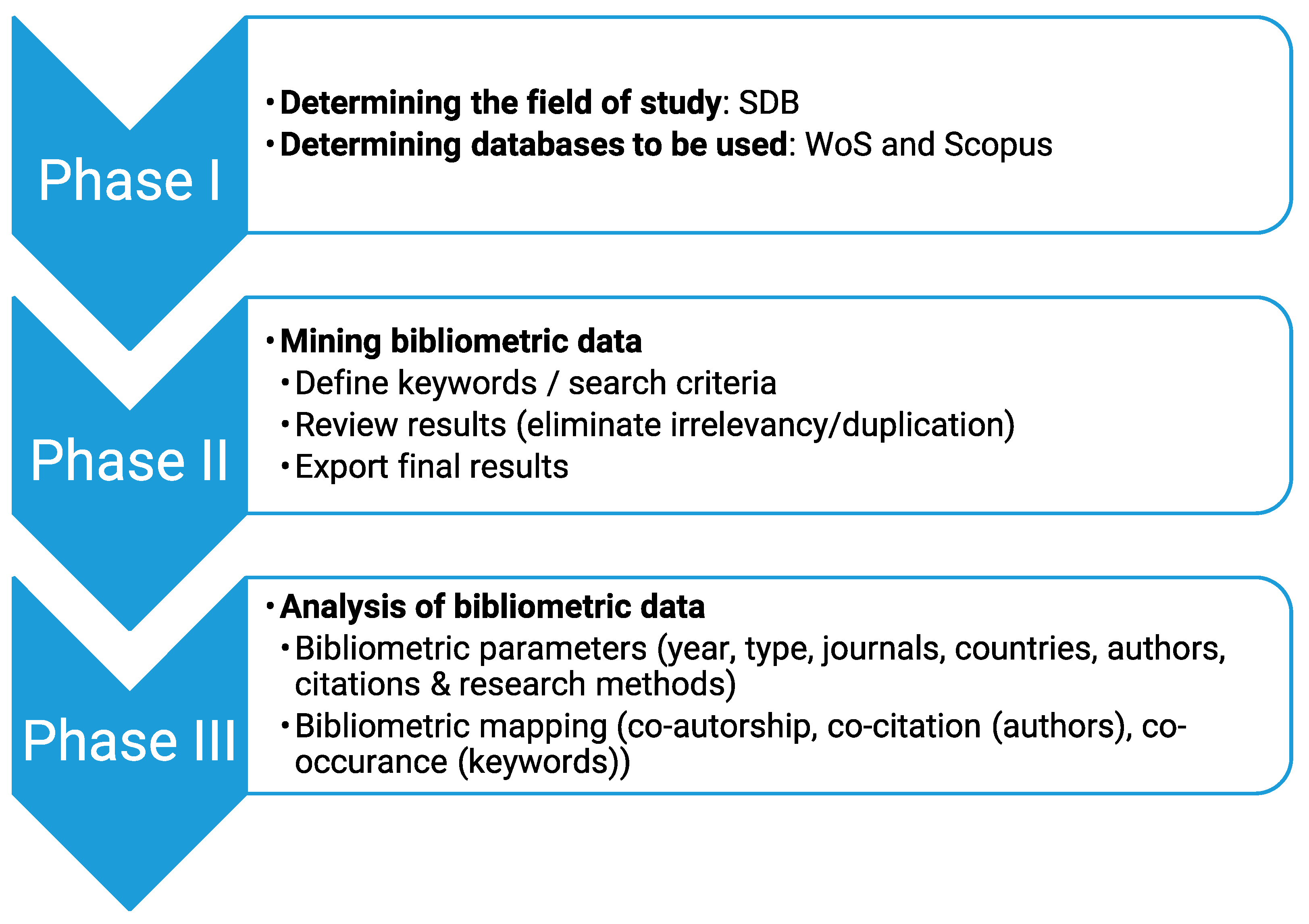
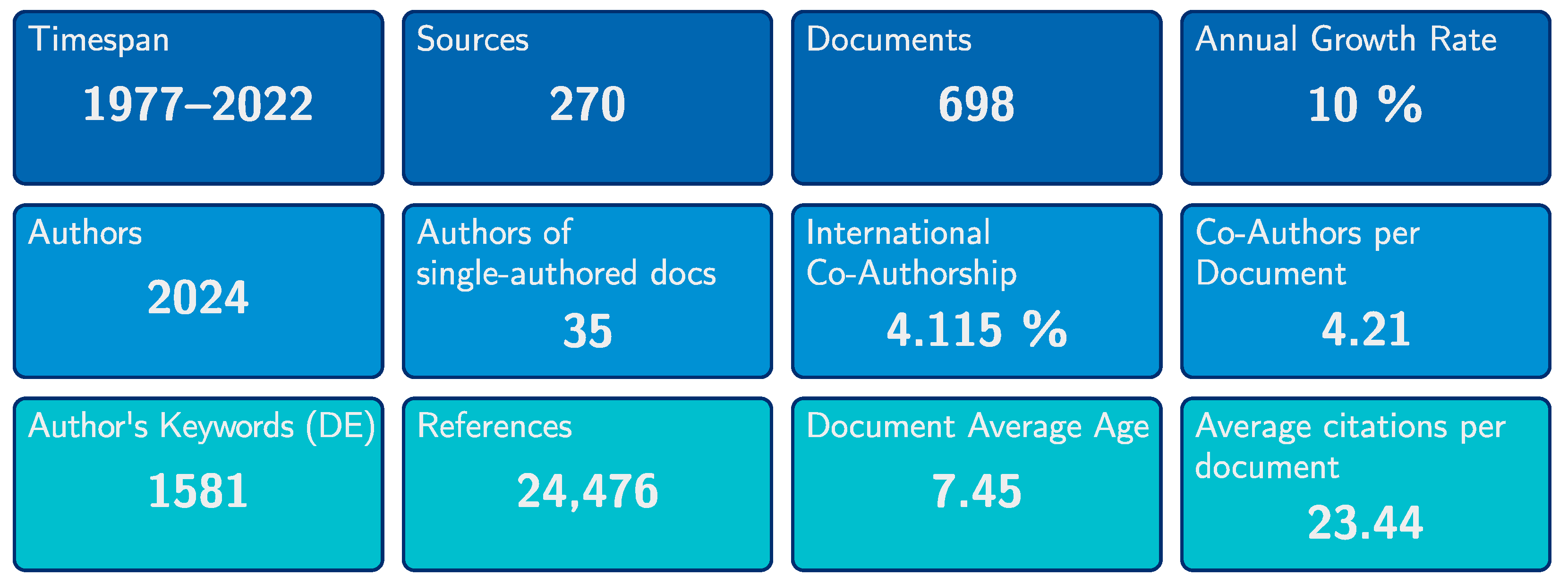
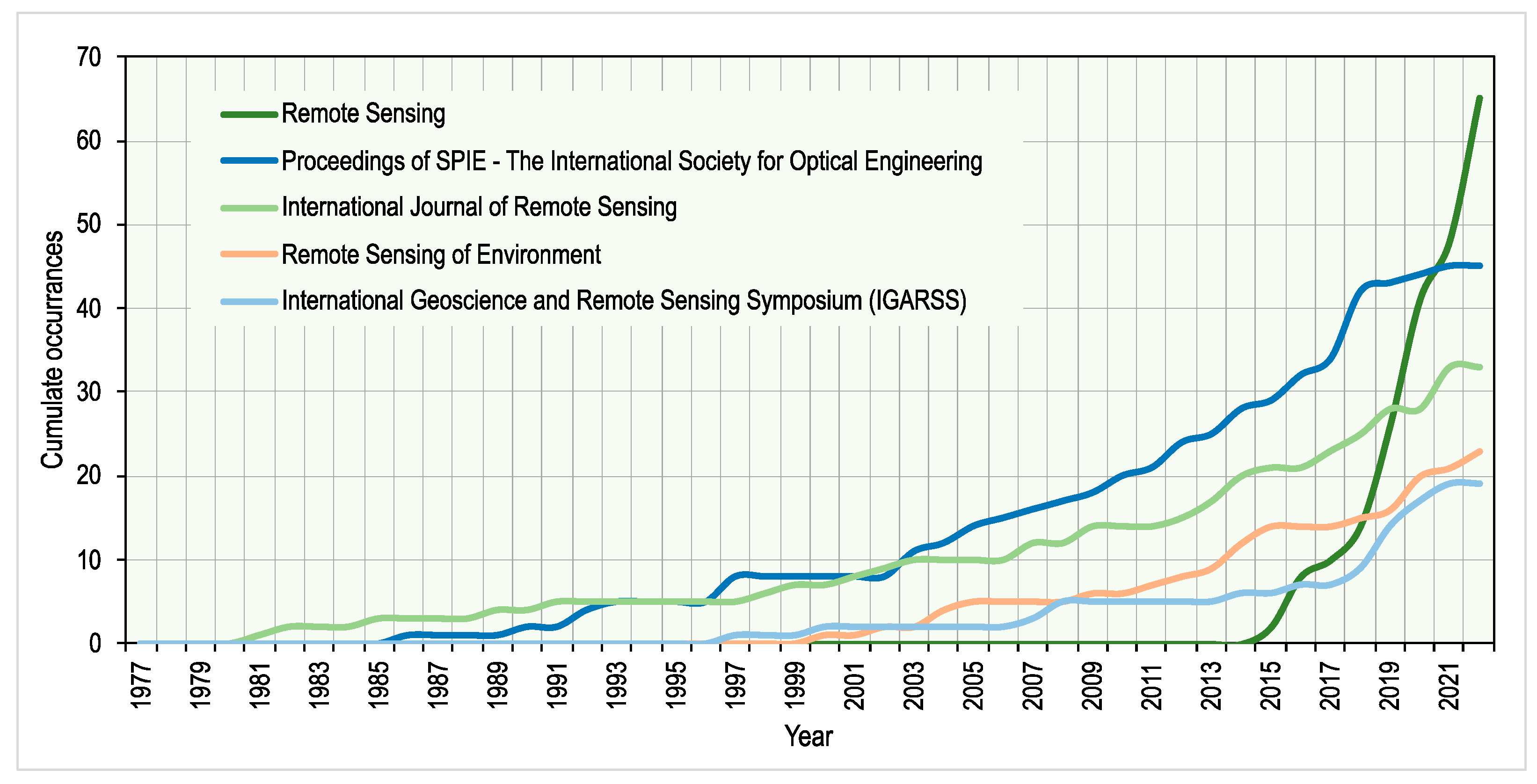
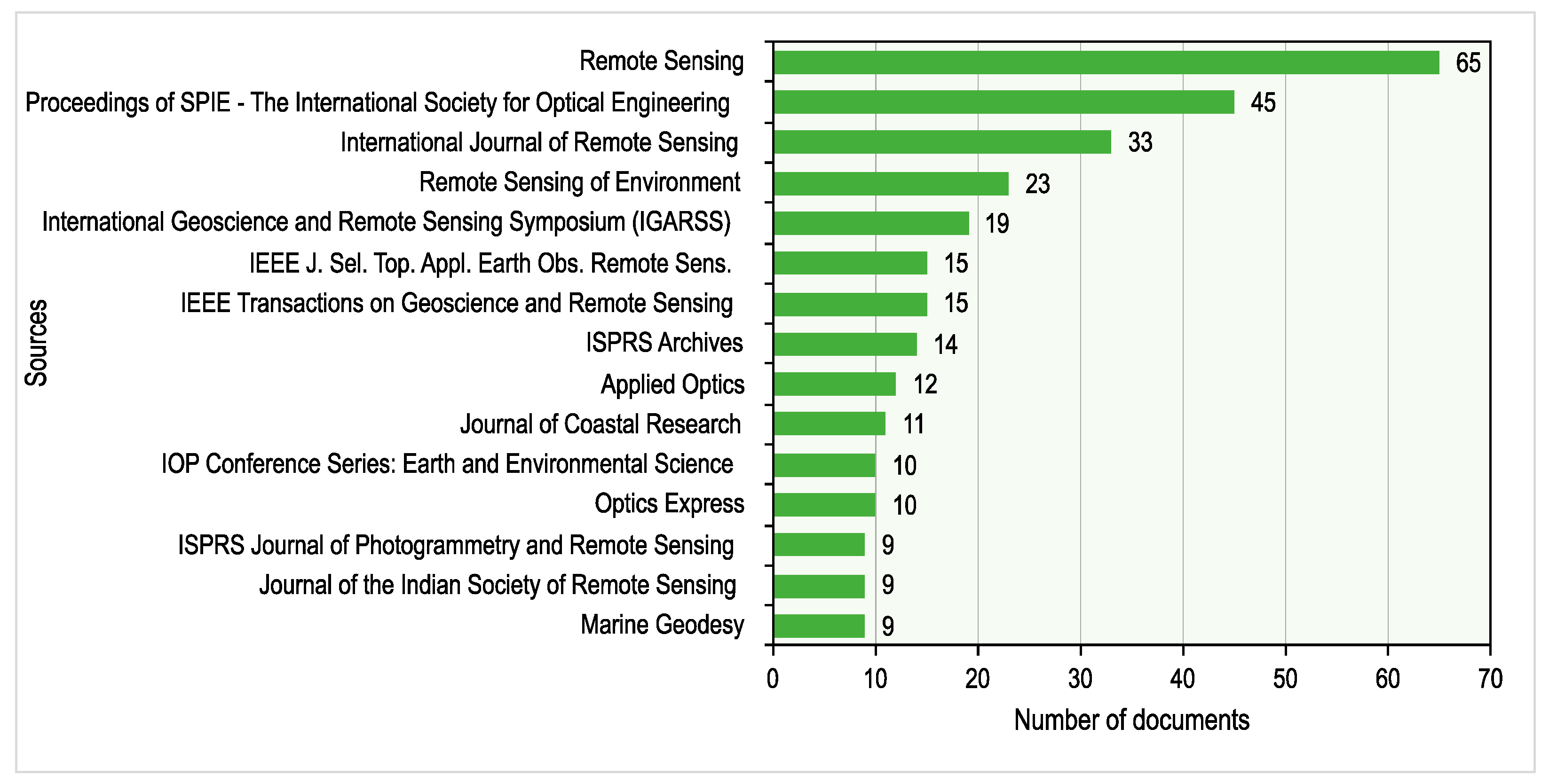
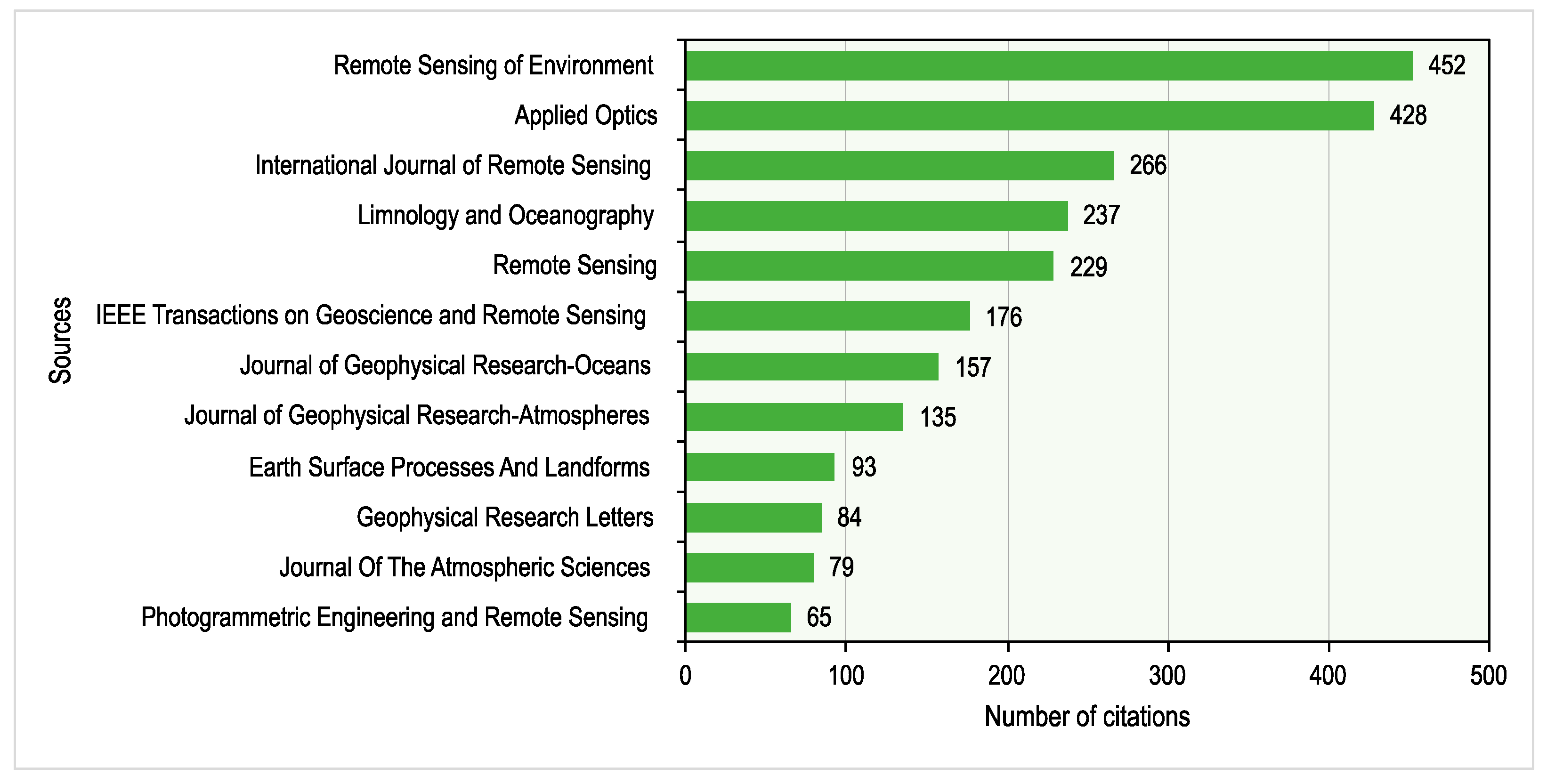

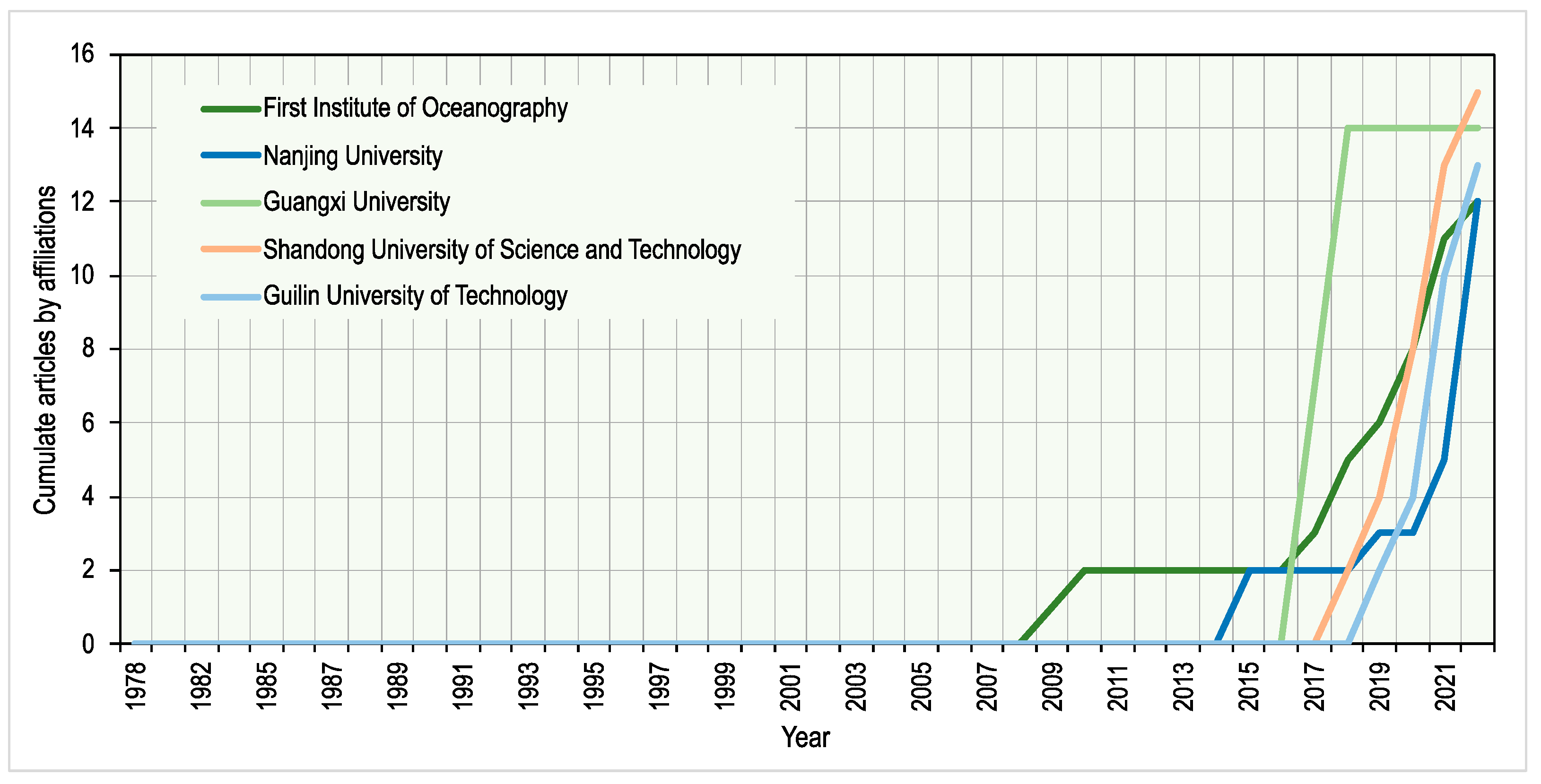

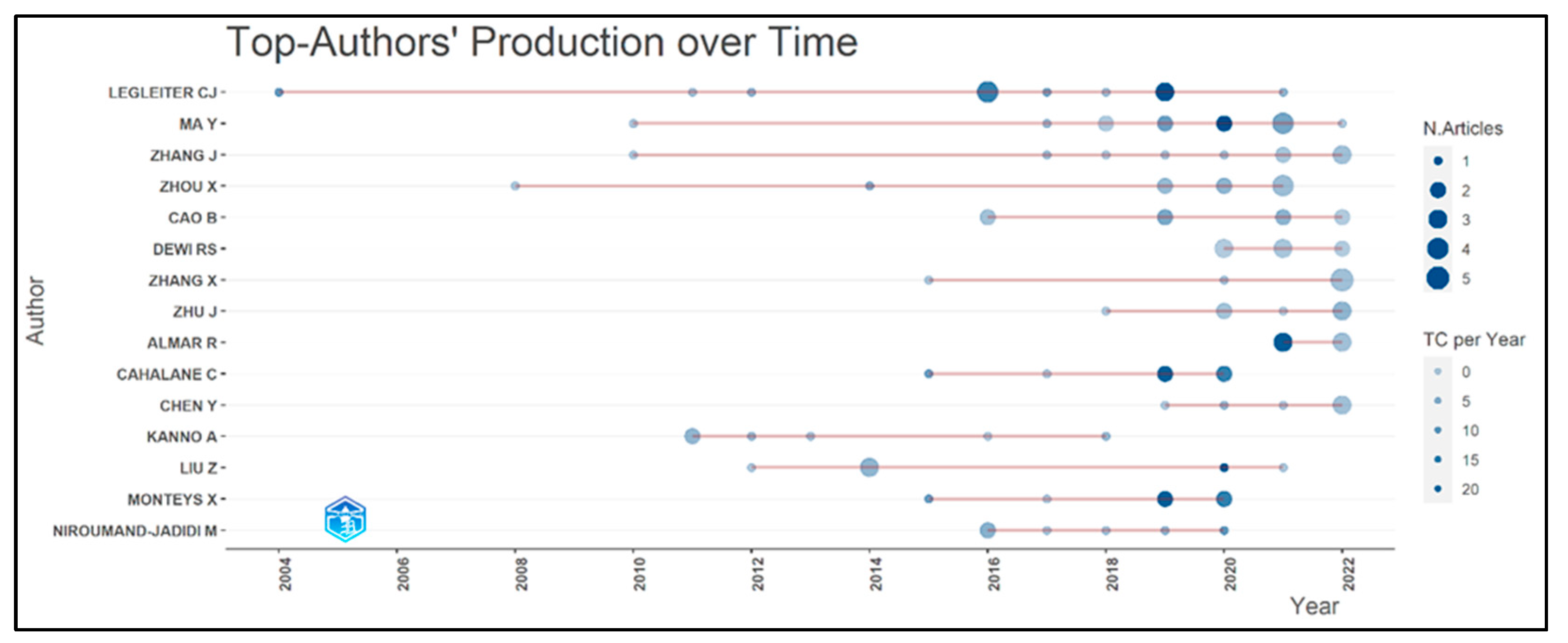

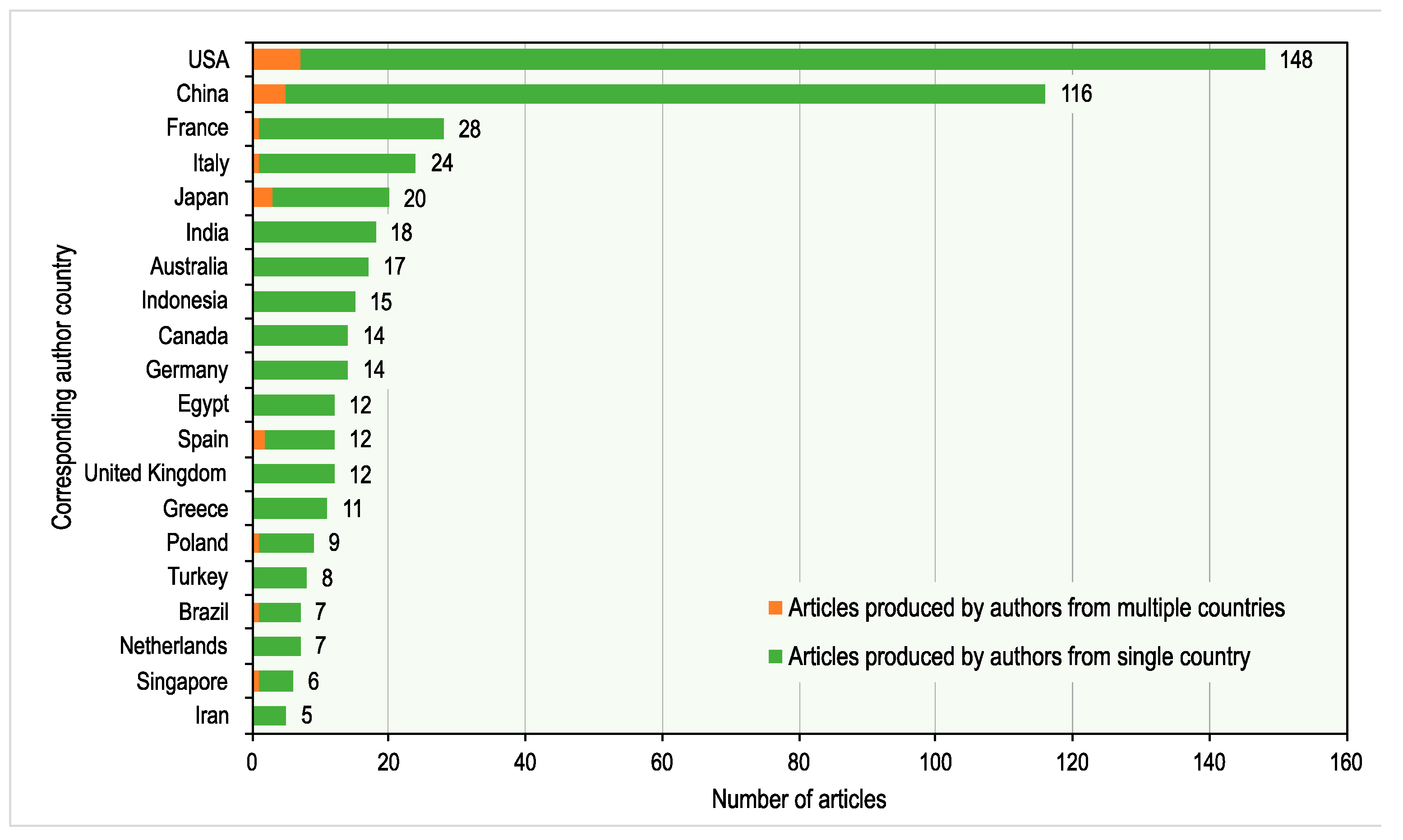
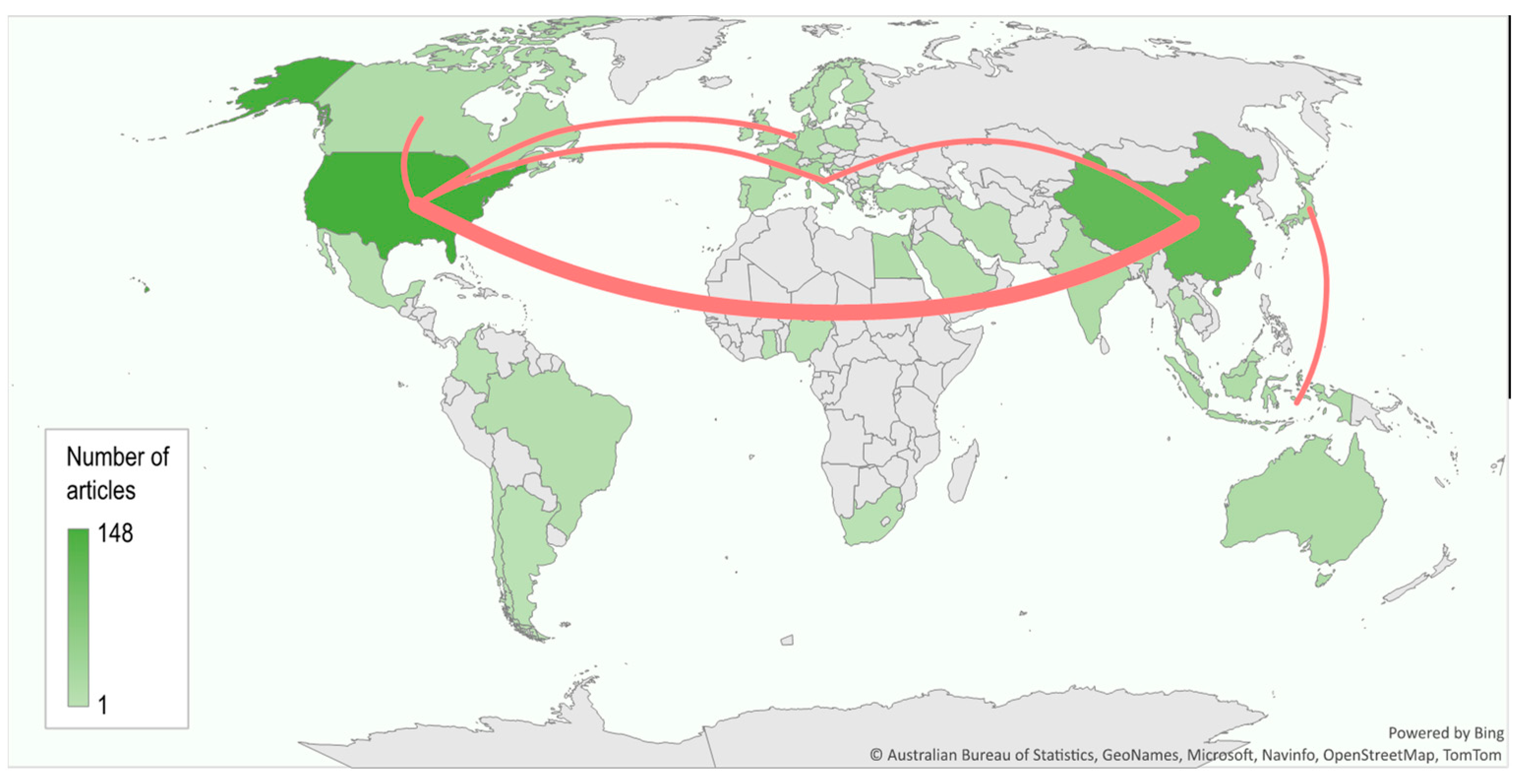
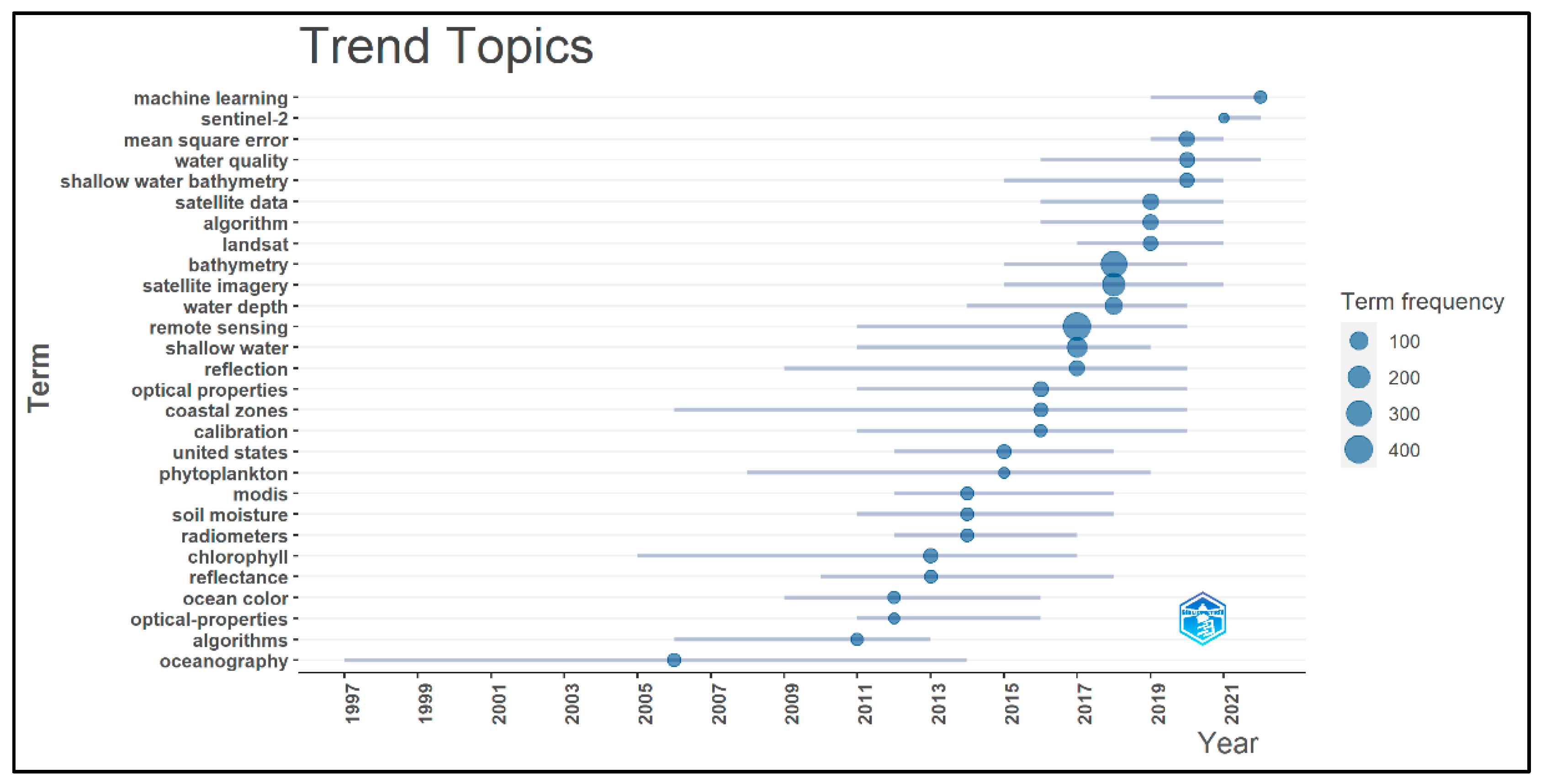

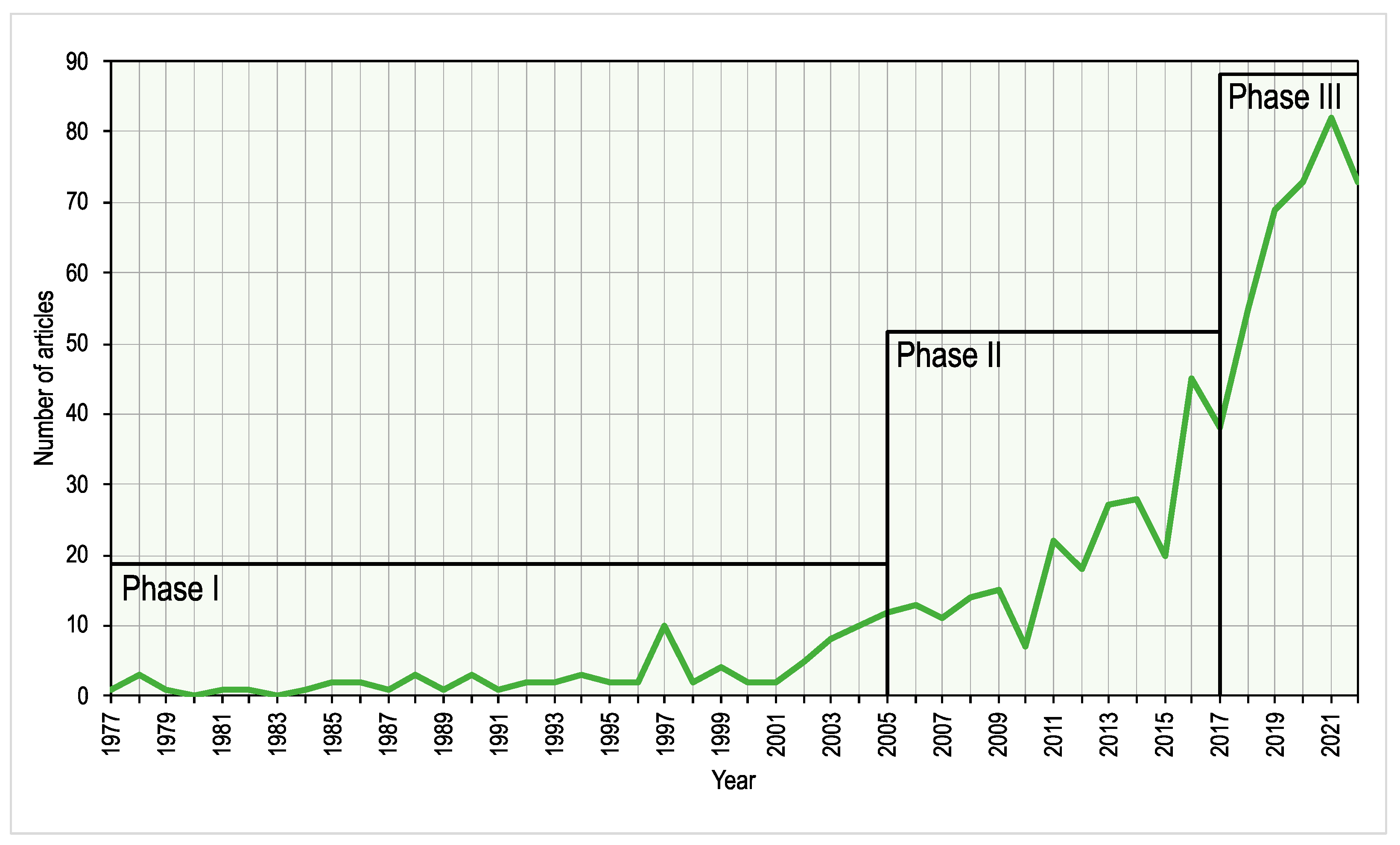
| Year | Reference | Approach | Resolution | Output | Applicability |
|---|---|---|---|---|---|
| 1974 | Gordon and Brown [31] | Algebraic | Multi and Hyperspectral | ρ index | Assumes homogeneous environment and empirical determination of parameters. |
| 1978 | Lyzenga [7] | Band combination | Multispectral | Combination of bands | First “empiric” model (1978) applicable in high-transparency waters and homogeneous bottoms. Poor in shallow waters. |
| 1987 | Spitzer and Dirks [8] | Band combination | Multispectral | Composition of 2 to 3 bands | Developed for SPOT and Landsat. Same as Lyzenga. |
| 1994 | Maritorena et al. [32] | Algebraic | Multi and Hyperspectral | ρ index | Assumes a homogeneous environment and high transparency. |
| 1994 | Bierwirth et al. [33] | Algebraic | Multi and Hyperspectral | ρ derivation | Needs clear water. Yields composite maps of depths structure and bottom reflectance. |
| 1996 | Tassan [34] | Band combination | Multispectral | Combination of bands | Sequential application to turbidity gradients. |
| 1999 | Lee et al. [26] | Algebraic | Multispectral | ρ index | Semi-analytical. Uses detailed IOP and assumes a homogeneous environment. |
| 2003 | Louchard et al. [35] | Optimized matching | Hyperspectral | Bottom types, Z and OAC | Requires careful preparation of spectral library. |
| 2004 | Purkis and Pasterkamp [36] | Algebraic | Multispectral | ρ index | Assumes high transparency and needs good map references. |
| 2006 | Conger et al. [37] | Band combination | Multi and Hyperspectral | Pseudo-color bands | Assumes a homogeneous environment. Ineffective in the red band. |
| 2008 | Bertels et al. [38] | Geo-morphologic | Multi and Hyperspectral | Bottom types, Z and OAC | Suitable to reefs of consistent bottoms and environment. |
| 2010 | Sagawa et al. [39] | Band combination | Multi and Hyperspectral | ρ index | Suitable to poor transparent waters but needs good map references. |
| 2010 | Yang et al. [40] | Algebraic | Multispectral | ρ index | Analytical. Suitable to the multi-layered water column. |
| 2005 | CRISTAL [41] | Optimized matching | Hyperspectral | Bottom types, Z and OAC | Requires careful preparation of spectral library. |
| 2007 | BRUCE [42] | Optimized matching | Hyperspectral | Bottom types, Z and OAC | Requires careful preparation of spectral library. Useful in low diversity areas. |
| 2014 | SAMBUCA-Brando et al. [43] | Algebraic | Hyperspectral | Bottom types, Z and OAC | Assumes that the bottom is a linear combination of two substrates. Derived adaptation of Lee et al.’s inversion scheme to optimize depth retrieval. |
| 2015 | SWAM [44] | Algebraic | Hyperspectral | Bottom types, Z and OAC | Adaptation of SAMBUCA developed for integration into SNAP/Sentinel-2 toolbox. This still needs software optimization to make it perform and be user-friendly. |
| 2012 | BOMBER [45] | Algebraic | Hyperspectral | Bottom types, Z and OAC | Derived adaptation of Lee et al.’s inversion scheme to optimize bio-optical outputs. |
| 2008 | Hedley’s Image Data Analysis (IDA, ex-ALUT) [46] | Optimized matching | Hyperspectral | Bottom types, Z and OAC | Derived adaptation of Lee et al.’s inversion scheme. A user-friendly workhorse that optimizes computing time by subdividing parameter space. |
| 2019 | PIF [47] | Multitemporal analysis | Multi and Hyperspectral | Bottom types, Z and OAC | Pseudo-invariant features using DNs (digital numbers) of the co-registered time series of the same satellite. |
| Journal Name (ISSN) | NP | NC | NC/NP | HI | IF | CS | SJR | BQ |
|---|---|---|---|---|---|---|---|---|
| Remote Sensing (Basel) (ISSN: 2072-4292) | 56 | 860 | 15.37 | 17 | 5.349 | 7.4 | 144 | Q1 |
| Remote Sensing of Environment (ISSN: 344257) | 18 | 1360 | 75.56 | 15 | 13.850 | 20.7 | 3.862 | Q1 |
| International Journal of Remote Sensing (ISSN: 01431161) | 17 | 874 | 51.41 | 11 | 3.531 | 6.5 | 0.873 | Q1 |
| Applied Optics (ISSN: 1559-128X) | 11 | 1174 | 106.73 | 9 | 1.905 | 3.8 | 0.581 | Q2 |
| IEEE Transactions on Geoscience and Remote Sensing (ISSN: 01962892) | 11 | 651 | 59.18 | 7 | 8.125 | 12.2 | 2.404 | Q1 |
| IEEE Journal of Selected Topics in Applied Earth Observations and Remote Sensing (ISSN: 19391404) | 10 | 124 | 12.40 | 3 | 4.715 | 6.4 | 1.335 | Q1 |
| Journal of Coastal Research (ISSN 0749-0208) | 10 | 178 | 17.8 | 4 | 1.11 | 1.2 | 0.237 | Q3 |
| Estuarine, Coastal and Shelf Science (ISSN: 0272-7714) | 8 | 206 | 25.75 | 7 | 3.229 | 5.3 | 0.875 | Q1 |
| IEEE Geoscience and Remote Sensing Letters (ISSN: 1545598X) | 8 | 88 | 11.00 | 5 | 5.343 | 8.5 | 1.403 | Q1 |
| Journal of the Indian Society of Remote Sensing (ISSN: 0255660X) | 8 | 12 | 1.50 | 3 | 1.894 | 2.2 | 0.405 | Q2 |
| Optics Express (ISSN: 10944087) | 8 | 160 | 20.00 | 6 | 3.894 | 7.2 | 1.233 | Q1 |
| ISPRS Journal of Photogrammetry and Remote Sensing (ISSN: 09242716) | 7 | 187 | 26.71 | 6 | 11.774 | 17.6 | 3.481 | Q1 |
| Marine Geodesy (ISSN 01490419, 1521060X) | 7 | 150 | 21.43 | 4 | 1.579 | 3.0 | 0.448 | Q1 |
| Geomorphology (ISSN: 0169555X) | 6 | 178 | 29.67 | 6 | 4.406 | 7.3 | 1.207 | Q1 |
| Journal of Applied Remote Sensing (ISSN: 19313195) | 6 | 99 | 16.50 | 3 | 1.568 | 3.0 | 0.471 | Q2 |
| Sensors (ISSN: 14243210) | 6 | 96 | 16.00 | 4 | 3.847 | 15.0 | 0.803 | Q1 |
| Author/S | AT | Affiliation | CO | CI | HI | ORCID |
|---|---|---|---|---|---|---|
| Legleiter Carl J. | 13 | United States Geological Survey, Reston | USA | 2494 | 30 | 0000-0003-0940-8013 |
| Ma Yi | 13 | Ministry Nat Resources, Inst Oceanog, Qingdao | China | 725 | 15 | 0000-0001-7710-7752 |
| Zhang Jingyu | 10 | Ministry of Land and Resources P.R.C., Beijing | China | 35 | 4 | 0000-0001-9120-7354 |
| Zhou Xinghua | 10 | Ministry of Land and Resources P.R.C., Beijing | China | 314 | 9 | not found |
| Cao Bin | 8 | Sun Yat-Sen University, Guangzhou | China | 82 | 5 | 0000-0002-1088-9603 |
| Dewi Ratna Sari | 8 | Research Division of Geospatial Information Agency of Indonesia, Bogor, Jawa Barat, | Indonesia | 238 | 9 | 0000-0003-3396-2954 |
| Zhang Xuechun | 7 | Ministry of Land and Resources P.R.C., Beijing | China | 6 | 1 | not found |
| Zhu Jianhua | 7 | Department at State Oceanic Administration, National Ocean Technology Center, Tianjin | China | 469 | 12 | 0000-0002-6659-8442 |
| Almar Rafael | 5 | Laboratoire d’Etudes en Géophysique et Océanographie Spatiales, Toulouse | France | 2357 | 27 | 0000-0001-5842-658X |
| Cahalane Conor | 6 | Maynooth University, Dept Geog, Kildare | Ireland | 304 | 9 | 0000-0003-1657-5688 |
| Chen Yifu | 6 | Key Laboratory of Geological Survey and Evaluation of Ministry of Education, Wuhan | China | 93 | 5 | not found |
| Kanno Ariyo | 6 | Graduate School of Science and Engineering, Yamaguchi University, Ube | Japan | 467 | 13 | 0000-0003-3162-7327 |
| Liu Zhen | 6 | Shandong University of Science and Technology, Qingdao | China | 73 | 3 | not found |
| Monteys Xavier | 6 | Geological Survey Ireland, Dublin | Ireland | 769 | 15 | 0000-0003-4733-3681 |
| Niroumand-Jadidi Milad | 6 | Deutsches Zentrum für Luft- und Raumfahrt (DLR), Cologne | Germany | 305 | 10 | 0000-0002-9432-3032 |
| Overstreet Brandon T. | 6 | University of Wyoming, Dept Geol and Geophys LARAMIE, WY | USA | 725 | 15 | 0000-0001-7845-6671 |
| QI Jiawei | 6 | College of Geodesy and Geomatics, Shandong University of Science and Technology, Qingdao | China | 9 | 2 | 0000-0001-8379-3293 |
| Author/S | AT | Affiliation | CO | CI | HI | ORCID |
|---|---|---|---|---|---|---|
| Legleiter Carl J. | 10 | United States Geological Survey, Reston | USA | 2494 | 30 | 0000-0003-0940-8013 |
| Ma Yi | 9 | Ministry Nat Resources, Inst Oceanog, Qingdao | China | 725 | 15 | 0000-0001-7710-7752 |
| Zhang Jingyu | 7 | Ministry of Land and Resources P.R.C., Beijing | China | 34 | 4 | 0000-0003-0825-8690 |
| Kanno Ariyo | 7 | Graduate School of Science and Engineering, Yamaguchi University, Ube | Japan | 467 | 13 | 0000-0003-3162-7327 |
| Negm Abdelazim | 6 | Faculty of Engineering, Zagazig University, Zagazig | Egypt | 1239 | 18 | 0000-0002-4838-5558 |
| Overstreet Brandon T. | 6 | University of Wyoming, Dept Geol and Geophys LARAMIE, WY | USA | 725 | 15 | 0000-0001-7845-6671 |
| Cao Bin | 6 | Sun Yat-Sen University, Guangzhou | China | 82 | 5 | 0000-0002-1088-9603 |
| Caballero Isabel | 5 | Instituto de Ciencias Marinas de Andalucía (ICMAN), Consejo Superior de Investigaciones Científicas (CSIC), Cadiz | Spain | 644 | 16 | 0000-0001-7485-0989 |
| Monteys Xavier | 5 | Geological Survey Ireland, Dublin | Ireland | 769 | 15 | 0000-0003-4733-3681 |
| Niroumand-Jadidi Milad | 5 | Deutsches Zentrum für Luft- und Raumfahrt (DLR)disabled, Cologne | Germany | 305 | 10 | 0000-0002-9432-3032 |
| Harris Paul | 5 | Rothamsted Research, Harpenden, Devon | UK | 1543 | 21 | not found |
| Carder Kendall L. | 5 | College of Marine Science, University of South Florida, St Petersburg, Florida | USA | 12867 | 49 | not found |
| Deng Ruru | 5 | Sun Yat Sen University, Sch Geog and Planning, Guangzhou, Guangdong | China | 611 | 11 | 0000-0002-4560-2000 |
| Alevizos Evangelos | 5 | Fdn Res and Technol Hellas FORTH, Inst Mediterranean Studies, Rethimnon | Greece | 209 | 7 | 0000-0001-7276-8666 |
| Cahalane Conor | 5 | Maynooth University, Dept Geog, Kildare | Ireland | 304 | 9 | 0000-0003-1657-5688 |
| Almar Rafael | 5 | Laboratoire d’Etudes en Géophysique et Océanographie Spatialesdisabled, Toulouse | France | 2357 | 27 | 0000-0001-5842-658X |
| Poursanidis Dimitris | 5 | Foundation for Research and Technology, Heraklion, Crete | Hellas | 1866 | 28 | 0000-0003-3228-280X |
| Hedley John D. | 5 | Numerical Optics Ltd., Witheridge | UK | 1587 | 19 | 0000-0003-3675-3736 |
| Author/S DOI | Year | Journal | Articles Titles | CI |
|---|---|---|---|---|
| Lee, Z.; et al. 10.1364/AO.37.006329 [26] | 1999 | Appl. Opt. | Hyperspectral Remote Sensing for Shallow Waters: 2. Deriving Bottom Depths and Water Properties by Optimization | 598 |
| Lyzenga, D. R.; 10.1364/AO.17.000379 [7] | 1978 | Appl. Opt. | Passive Remote Sensing Techniques for Mapping Water Depth and Bottom Features | 592 |
| Stumpf, R.P.; et al.; 10.4319/lo.2003.48.1_part_2.0547 [13] | 2003 | Limnol. Oceanogr. | Determination of Water Depth with High-Resolution Satellite Imagery over Variable Bottom Types | 477 |
| Lee, Z.P., et al.; 10.1364/AO.37.006329 [72] | 1998 | Appl. Opt. | Hyperspectral Remote Sensing for Shallow Waters. I. A Semianalytical Model | 434 |
| Maritorena, S.; 10.4319/LO.1994.39.7.1689 [32] | 1994 | Limnol. Oceanogr. | Diffuse-Reflectance of Oceanic Shallow Waters: Influence of Water Depth and Bottom Albedo | 297 |
| Stramski, D., et al.; 10.1016/j.pocean.2004.07.001 [73] | 2004 | Prog. Oceanogr. | The Role of Seawater Constituents in Light Backscattering in the Ocean | 290 |
| Lyzenga, D. R.; 10.1109/TGRS.2006.872909 [74] | 2006 | IEEE Trans. Geosci. Remote Sens. | Multispectral Bathymetry using a Simple Physically Based Algorithm. | 255 |
| Brando, V.E.; 10.1016/J.RSE.2008.12.003 [43] | 2009 | Remote Sens. Environ. | A Physics Based Retrieval and Quality Assessment of Bathymetry from Suboptimal Hyperspectral Data | 176 |
| Lyzenga, D. R.; 10.1080/01431168508948428 [12] | 1985 | Int. J. Remote Sens. | Shallow-Water Bathymetry Using Combined LIDAR and Passive Multispectral Scanner Data | 175 |
| Giardino, C., et al.; 10.1016/S0048-9697(00)00692-6 [75] | 2001 | Sci. Total Environ. | Detecting Chlorophyll, Secchi Disk Depth and Surface Temperature in a Sub-Alpine Lake Using Landsat Imagery | 170 |
| Legleiter, C.J., et al.; 10.1002/esp.1787 [76] | 2009 | Earth Surf. Process. Landf. | Spectrally Based Remote Sensing of River Bathymetry | 163 |
| Winterbottom, S.J.; et al.; 10.1002/(SICI)1099-1646(199711/12)13:6<489::AID-RRR471>3.0.CO;2-X [77] | 1997 | Regul. Rivers Res. Manag. | Quantification of Channel Bed Morphology in Gravel-Bed Rivers Using Airborne Multispectral Imagery and Aerial Photography | 148 |
| Legleiter, C.J., et al.; 10.1016/j.rse.2004.07.019 [78] | 2004 | Remote Sens. Environ. | Passive Optical Remote Sensing of River Channel Morphology and In-Stream Habitat: Physical Basis and Feasibility | 144 |
| Casella, E., et al.; 10.1007/s00338-016-1522-0 [79] | 2017 | Coral Reefs | Mapping Coral Reefs Using Consumer-Grade Drones and Structure from Motion Photogrammetry Techniques | 143 |
| Dietrich, J.T.; 10.1002/esp.4060 [80] | 2017 | Earth Surf. Process. Landf. | Bathymetric Structure-from-Motion: Extracting Shallow Stream Bathymetry from Multi-View Stereo Photogrammetry | 133 |
| Keywords Plus | Occurrences |
|---|---|
| remote sensing | 405 |
| bathymetry | 343 |
| satellite imagery | 214 |
| shallow water (shallow waters) | 142 |
| water depth | 89 |
| optical radar | 85 |
| hydrographic surveys | 72 |
| satellites | 71 |
| mapping | 64 |
| satellite data | 62 |
| algorithm | 54 |
| mean square error | 54 |
| reflection | 50 |
| optical properties | 47 |
| water quality | 46 |
Disclaimer/Publisher’s Note: The statements, opinions and data contained in all publications are solely those of the individual author(s) and contributor(s) and not of MDPI and/or the editor(s). MDPI and/or the editor(s) disclaim responsibility for any injury to people or property resulting from any ideas, methods, instructions or products referred to in the content. |
© 2023 by the authors. Licensee MDPI, Basel, Switzerland. This article is an open access article distributed under the terms and conditions of the Creative Commons Attribution (CC BY) license (https://creativecommons.org/licenses/by/4.0/).
Share and Cite
Duplančić Leder, T.; Baučić, M.; Leder, N.; Gilić, F. Optical Satellite-Derived Bathymetry: An Overview and WoS and Scopus Bibliometric Analysis. Remote Sens. 2023, 15, 1294. https://doi.org/10.3390/rs15051294
Duplančić Leder T, Baučić M, Leder N, Gilić F. Optical Satellite-Derived Bathymetry: An Overview and WoS and Scopus Bibliometric Analysis. Remote Sensing. 2023; 15(5):1294. https://doi.org/10.3390/rs15051294
Chicago/Turabian StyleDuplančić Leder, Tea, Martina Baučić, Nenad Leder, and Frane Gilić. 2023. "Optical Satellite-Derived Bathymetry: An Overview and WoS and Scopus Bibliometric Analysis" Remote Sensing 15, no. 5: 1294. https://doi.org/10.3390/rs15051294
APA StyleDuplančić Leder, T., Baučić, M., Leder, N., & Gilić, F. (2023). Optical Satellite-Derived Bathymetry: An Overview and WoS and Scopus Bibliometric Analysis. Remote Sensing, 15(5), 1294. https://doi.org/10.3390/rs15051294







